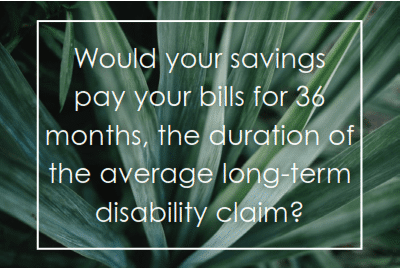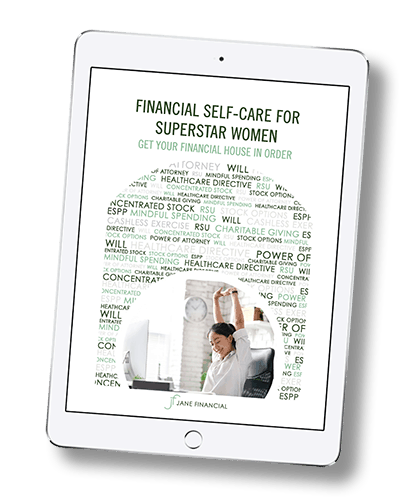Disability Insurance: Hope for the Best, Prepare for the Worst
COVID-19 continues to rage around the world. A young product manager and MIT graduate shared her sad story of being unable to work since recovering from a viral infection like COVID-19 in 2009. This SF Chronicle story shares COVID-19 survivors’ real-time struggles. These survivors, or “long-haulers,” face a slow and painful recovery.
Two close friends were recently diagnosed with breast cancer. They’re only 38 and 41 years old. Clients have told me about their friends in their late 30s fighting other forms of cancer. The severity of their illnesses prevented them from working for several months.
Would Your Savings Last 36 Months?

A catastrophic illness is unlikely in your 30s and 40s, but it’s not impossible. Would your savings pay your bills if you were unable to work for months? The average long-term disability claim is 36 months.
Even if you wanted to return to work, a 2014 study by Dr. Reshma Jagsi revealed that a discouragingly low percentage of cancer survivors were working four years after their treatment was completed. She interviewed 746 early-stage breast cancer survivors under the age of 65. Of these women, 30% were no longer working at the time of a follow-up survey four years later; 55% of that group wanted to be working. The financial consequences could be devastating if you were unable to work.
A Solution: Disability Insurance
A disability income insurance policy is a solution if you become disabled, whether from an illness or an
injury. If you are unable to work, the policy would replace a certain percentage of your salary for the
duration of the disability or the length of the policy’s benefit period. You can either buy group disability
insurance through your job, or you can buy an individual policy through an insurance agent. If your
compensation is less than $400,000 per year, a group policy is likely sufficient.
Determine How Much You Need
First, get a handle on your annual necessities: fixed expenses (e.g., mortgage or rent, property tax if you’re a homeowner, utilities, healthcare expenses like an annual deductible) and variable expenses (e.g., groceries). Then consider other sources of income you may have (e.g., Social Security Disability Income, rental income, Veterans Affairs disability benefits). Calculate the net benefit amount you would need to pay for your basic living expenses.
Taxation of Disability Benefits
For individual disability policies, income benefits are generally exempt from income tax, and there is no limit on the amount of disability income benefits that can be received tax-free. For group disability policies, if your employer pays for the policy, disability income payments are be taxable to you. If you pay for the policy using pre-tax dollars, the disability income payments also are taxable. But if you pay for the policy using after-tax dollars, the payments are tax-free.
Key Terms
Definitions of Disability
Total disability (“own occupation”): the most favorable definition of disability. You’re unable to perform the major functions of your own regular occupation. If a marketing VP is unable to perform her corporate job, she’s considered disabled for the purposes of this type of definition.
Partial disability: you can’t perform some duties of your own occupation, but you can perform other duties. After a period of total disability, when you can return to work and perform 50% of your duties, for example, the policy would pay a 50% disability benefit payment.
Residual disability: let’s say you earned $17,000 per month before becoming disabled. If you return to work after six months but only earn $10,000 per month, the residual disability benefit would pay you $7,000 per month.
Benefit Period
A set amount of time (e.g., one year, five years), or until a certain age (e.g., age 65 or 70). Lifetime benefit periods aren’t widely available.
Elimination Period
The period after disability begins until the disability benefits begin. The commonly selected period is 90 days; the longer the elimination period, the lower the premium amount.
Benefit Amount
In a group policy, usually this is 66 2/3% of your base salary.
Renewability
Refers to whether and at what premium rate the policy is renewed:
Noncancelable: you have the right to renew coverage at the same rate, usually until age 65
Guaranteed Renewable: like noncancelable except that the insurance company can increase the premium (although the increase must apply to all policies that fall within a particular category, not just to your policy).
Conditionally Renewable: you must meet certain conditions to be able to renew the policy (e.g., you must be employed full-time). The insurer may raise premiums under this type of plan.





